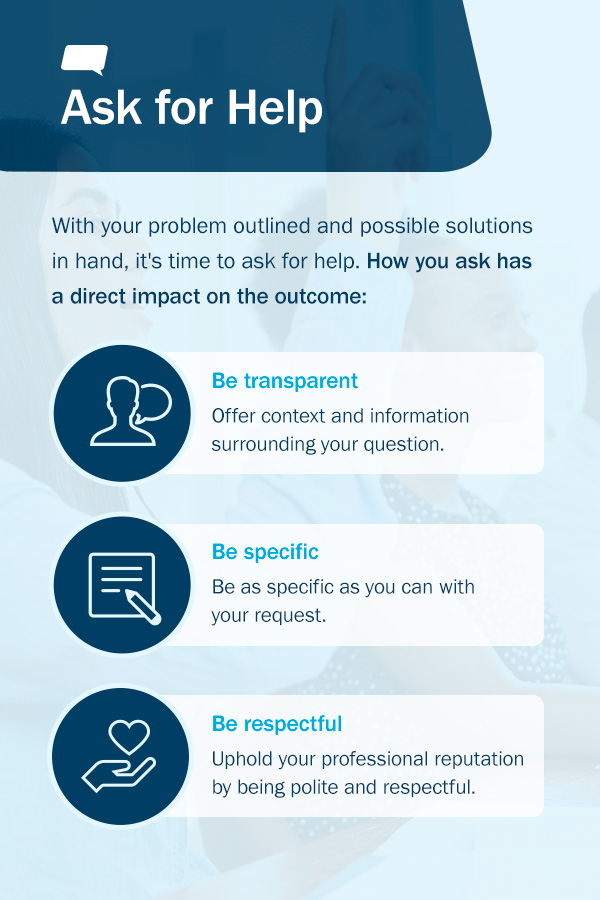


So, you’ve just landed a new job. Congratulations! Now it’s time to learn more about yourself as a person and a leader by asking for assistance at work. That’s right—no matter what your formal position is, everyone has the potential to influence the people around them. While it may make you feel vulnerable and nervous, asking for help is sometimes the only way to overcome a challenge and learn something new. Even the best leaders understand that they don’t know everything, and they can use the strengths of others to increase or supplement their own.
In this guide, you’ll learn how to ask for help at work and why it’s so essential. We’ve included plenty of scenarios and tips to give you the confidence to reach out, regardless of your situation.
Contact Us
Before we begin, know there is no shame in asking for help. It’s OK not to know all the answers because everyone needs direction. If you need help and don’t ask for it, you may limit yourself and your ability to complete a task or miss out on a significant growth opportunity. Follow these steps to advocate for yourself and reach out to someone who can provide you with the information and resources you need to be successful.
Your first goal is to figure out which task or issue you need help with. That seems obvious, but it’s essential to understand your request before you take it to someone else. This will help you get a handle on what you may be struggling with and find details you can ask about.
For example, you may be struggling with building the company website. Upon further inspection, you discover that you’re unsure how to create buttons, which is holding you back. Instead of saying, “I need help with building this website,” you can ask, “Can you show me how to code the buttons on the homepage?”

Before you ask someone, try to find the answer on your own. If it’s a simple question with a straightforward answer, Google your query or scour the company’s documentation to see if you can find it. Don’t dive too deep—if you can’t find the answer in a reasonable time and in an obvious place, then ask for help so you don’t waste more time.
If your question doesn’t have a clear answer and you need help choosing the approach you should take, use what’s available to you to come up with a list of options. Lay each option out and compare them to uncover which one you think is the best. You may find you’ve answered your own question, but if you’re still stuck, you can present your options and opinions to a colleague or manager to get their take on the issue. This extra step shows off your problem-solving skills and capability, even when asking for help.
Next, think about what type of help you need. This can include advice, explanations, information, tools or assistance. To help you with this step, we’ve provided a few scenarios and the type of help you may need if you’re in them.
More than anything, don’t accept incomplete coaching. If the person you are asking doesn’t know or doesn’t have the expertise, don’t be afraid to ask someone else who does. This is about your growth.

With your problem outlined and possible solutions in hand, it’s time to ask for help. How you ask has a direct impact on the outcome, and we’ve outlined some tips to ensure you ask in a professional, respectful and meaningful way.
If you’re struggling to find the right words or way to ask for what you need, here are three scenarios and the questions we suggest asking.
If you are totally new to a task, lack confidence and find yourself unsure where to start:
If you are new to a task and excited about it:
If you have experience, but for whatever reason, remain unsure or uncertain about your task:
While asking for help is nerve-wracking for most, some people may feel extra nervous or outright scared to approach others for help. This is completely understandable and normal—you’re putting yourself in a vulnerable position where you’ve admitted to not knowing something. But asking for help is a vital part of being a team player, growing your knowledge and skills, and ultimately becoming a better person and leader.
The most important thing is to realize that your fear is natural, and most people are incredibly willing to help others when they ask. The worst thing that can happen is they say they can’t help, and then you can move on to another person or attempt to resolve it yourself. Not asking can result in far more negative consequences—like making a mistake or missing a deadline—which will impact your work and the success of the business.

If you’re still nervous about requesting help at work, practice asking people you’re comfortable with. Observe how other people ask for help in your work environment and try to emulate them. You can even open up to your colleagues about your fear and ask them for advice. They’ll probably love the opportunity to connect with you over something they’ve likely experienced as well.
We’ve mentioned that asking for help can help you learn and grow, but understanding exactly how it accomplishes this can help you see the importance of the act and encourage you to do it more often. When you ask for help at work, you’ll see the following benefits:
Note that progress isn’t linear. It’s OK if you get into the swing of things, find your footing and excel, but then find that you’re uncertain again. You may temporarily lose motivation or don’t have the necessary expertise to complete a new task. That’s a part of learning. Each new task will demand this growth journey, and even a familiar task can challenge you to level up your skills. The most essential factor is having the self-awareness to know your weaknesses and reach out for the information you need.
Whether it’s your first job or you’re on your way to stardom in your career, this ebb and flow of knowledge, skill and willpower will continue with each task you do. And you’ll learn to move with it.
Learning how to ask for help is just one way of becoming an effective leader. If you’re interested in leveling up your skills even further, consider taking a course or workshop at The Center for Leadership Studies. We offer many public, private, online, virtual and blended training opportunities centered around our Situational Leadership® Model. It’s the world’s most widely recognized leadership model, and 70% of Fortune 500 companies use it to improve their leadership abilities.
You can enroll in our Situational Performance Ownership® course to learn more about taking a proactive approach to your development by identifying and communicating your performance needs. Contact us today to get started!